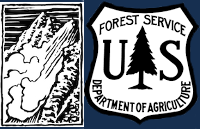24-25
A few inches of new snow and good stability
We rode into Tepee Basin along the headwall and up to the wilderness boundary. There had been a number of small releases of roller balls in steep rocky terrain but nothing got legs and ran. It would be hard to classify any of the activity, even as small wet loose avalanches. Crusts stayed robust and supportable throughout the day.
There was 2-3” new snow at the bottom of the basin and 4–5 inches up near the wilderness boundary. Winds were calm, and there was no active wind loading. The new snow throughout the basin got moist during the heat of the day. North-facing slopes at upper elevations stayed cool and mostly dry.
We had a nice late-season ride. Avalanches are unlikely under the current status quo. Today, the primary problem was isolated wind-slab instability in upper-wind-exposed terrain. Overall, there are safe avalanche conditions.
A significant warm-up or a significant pulse of snow would change the equation. At this point, it seems like most of the snow around has been transformed by warm temperatures over the last few weeks. I am more worried about new snow than a warm-up.
Various instabilties up high
Toured out of beehive basin yesterday (4/22). I spotted a storm slab avalanche on a northeast-facing slope at 9400 ft It was fairly far away, but the debris pile was decently sized. While skiing a northwest aspect in the high alpine, I pulled out several small wind slab pockets, including one that propagated about 10 ft and was a foot or so deep. These slabs were beginning to set up and weren't super touchy. Later in the day, I saw a small point release originating from an east-facing rock band at around 10000 ft.
Touchy wind slab on Bridger Ridge
NE facing ridgeline near Hidden Couloir was touchy, with a 6-8” stiff wind slab breaking quite easily underfoot. Not the first person to ski Hidden, so observed this slab was not propagating far, but was breaking easily as temps heated up.
Good Stability Texas Meadows Area
Toured through Bradley's Meadow today and N into the drainage and the backside of Texas Meadows. Approx 6" of dense, new snow. New snow has bonded well and we couldn't get anything to move or sluff. Zero shooting cracks, no collapsing on N, E, or S aspects. Nice skiing with the existing layer supporting the new snow.
GNFAC Avalanche Forecast for Mon Apr 21, 2025
<p><span><span><span><span><span><span>Any avalanche problems will involve the new snow. Otherwise, the snowpack is generally stable and larger avalanches are unlikely. Skiers or riders can trigger </span></span></span></span></span></span><span><span><span><strong><span><span>wind slab avalanches</span></span></strong></span></span></span><span><span><span><span><span><span>, around 4-8” deep, on steep slopes where the 4-5" of new snow has been drifted into thicker or stiffer slabs. Additionally, </span></span></span></span></span></span><span><span><span><strong><span><span>dry loose</span></span></strong></span></span></span><span><span><span><span><span><span> and </span></span></span></span></span></span><span><span><span><strong><span><span>wet loose</span></span></strong></span></span></span><span><span><span><span><span><span> </span></span></span></span></span></span><span><span><span><strong><span><span>avalanches</span></span></strong></span></span></span><span><span><span><span><span><span> are possible to trigger and could run long distances on firm crusts below the new snow. When the sun comes out, the new snow will quickly get wet and easily slide on steep, sunny slopes.</span></span></span></span></span></span></p>
<p><span><span><span><span><span><span>On Saturday skiers triggered small wind slab avalanches, 3-6” deep and 10-20’ wide, in the northern Bridgers (</span></span></span></span></span></span><a href="https://www.mtavalanche.com/node/34932"><span><span><span><strong><span… and photos</span></span></u></span></strong></span></span></span></a><span><span><span><span><span><span>) and near Cooke City (</span></span></span></span></span></span><a href="https://www.mtavalanche.com/images/25/small-wind-slab-and-dry-loose-sli…;). Today you might encounter similar drifts, or some slightly larger drifts in areas with more new snow.</span></span></span></span></span></span></p>
<p><span><span><span><span><span><span>Slides will be generally small, but any type of avalanche can be hazardous in terrain where they could push you into rocks, trees, over a cliff, or carry you a long way down a steep slope. Before riding steep slopes, assess the terrain for consequences of being knocked over by a small slide. </span></span></span></span></span></span></p>
<p><span><span><span><span><span><span>Be on the lookout for fresh drifts and avoid them, especially in consequential terrain. Monitor the snow surface for wet snow avalanche potential, and if it is becoming moist find lower angle terrain or shadier slopes with drier snow. </span></span></span></span></span></span></p>
<p><span><span><span><span><span><span>Daily forecasts are done for the season, but avalanches will continue. Remain diligent with your snowpack and terrain assessments, and be ready to adapt your plans to changing conditions. See below for more general spring snowpack and travel advice.</span></span></span></span></span></span></p>
Announcements
The Hyalite Canyon Road is closed to ALL MOTORIZED VEHICLES until May 16. This is a regular annual road closure to reduce road damage during the spring thaw. Bicycle and foot traffic are allowed.
